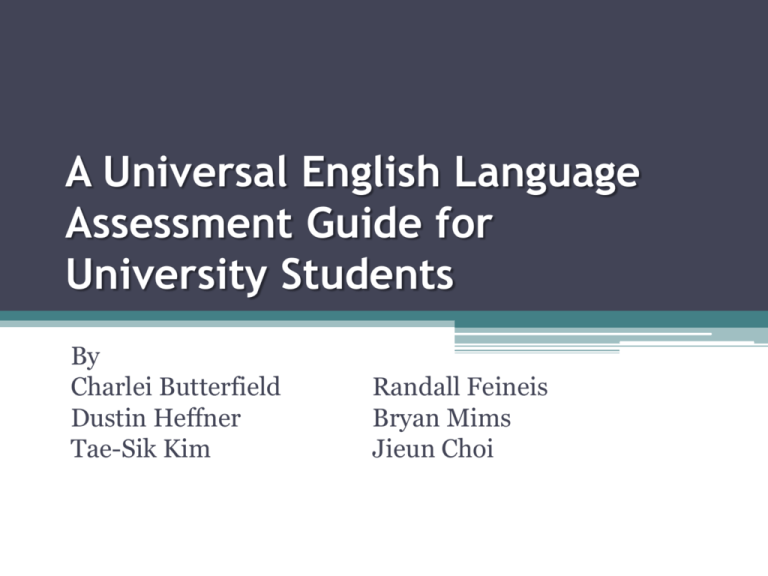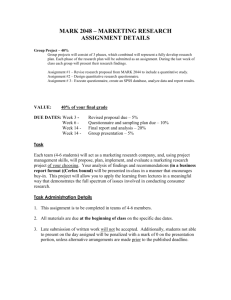A Universal English Language Assessment Guide for University
advertisement

A Universal English Language Assessment Guide for University Students By Charlei Butterfield Dustin Heffner Tae-Sik Kim Randall Feineis Bryan Mims Jieun Choi Vision Statement Our vision of this presentation is to effectively and efficiently introduce and explain a variety of assessment techniques that can be incorporated into freshman university English classes. Also, the goal is to provide an invaluable resource to all freshman instructors; in the hopes of creating a dynamic, enjoyable and practical course. Presentation Structure • Pre-Course ▫ Level Test • Introductory Lesson ▫ Questionnaire • In Class ▫ Teacher Assessment Strategies ▫ Peer Assessment • Exam Day ▫ Rubrics • Speaking Assessment Practice ▫ Video • Post Course ▫ Questionnaire Presentation Structure • Pre-Course ▫ Level Test • Introductory Lesson ▫ Questionnaire • In Class ▫ Teacher Assessment Strategies ▫ Peer Assessment • Exam Day ▫ Rubrics • Speaking Assessment Practice ▫ Video • Post Course ▫ Questionnaire Level Test • Parameters: ▫ Duration of 1-2 hours. ▫ Include sections on: Reading comprehension Grammar Listening Speaking Level Test • Parameters: ▫ The test should be clear and contain no discourse that might be: Culturally bias Age inappropriate Otherwise unsuitable. Level Test • Goal: ▫ Establish 3 Class levels: Advanced Classes (top 20%) Intermediate Classes (next 50%) Novice Classes (bottom 30%). Level Test • Part 1: Reading Comprehension ▫ The reading component should consist of 3-5 reading passages varying in length and difficulty. ▫ The texts should be culturally relevant. ▫ Questions should test the student’s ability to comprehend the reading and vocabulary. Link (Appendix A) Level Test • Part 2: Grammar ▫ Core focus will be on verb forms: Present simple Present continuous Simple past Future. ▫ Minor focus will be on the use of: Adverbs of frequency Adjectives Basic prepositions. continue Level Test • Part 2: Grammar ▫ Questions should test the student’s understanding of common English discourse and lexicon. ▫ Questions should not be static and should vary in difficulty and structure. Link (Appendix B) Level Test • Part 3: Listening Comprehension ▫ Short audio conversations between two individuals or monologues should be played of varying length and difficulty. ▫ Questions should be designed to test the student’s ability to comprehend the dialogue and discern pertinent data. continue Level Test • Part 3: Listening Comprehension ▫ Each audio segment should be accompanied with 1-3 questions. ▫ Each audio segment will be played only once. Link (Appendix C) Level Test • Part 4: Speaking ▫ The speaking portion should be broken down into the following categories: Read a passage out loud. Describe the picture. Short answer questions. Long answer questions. Link (Appendix D) Presentation Structure • Pre-Course ▫ Level Test • Introductory Lesson ▫ Questionnaire • In Class ▫ Teacher Assessment Strategies ▫ Peer Assessment • Exam Day ▫ Rubrics • Speaking Assessment Practice ▫ Video • Post Course ▫ Questionnaire English Questionnaire • Topics: ▫ General Information ▫ English Background ▫ English Confidence ▫ Korean Confidence ▫ Attitude Towards English Link (Appendix E) Presentation Structure • Pre-Course ▫ Level Test • Introductory Lesson ▫ Questionnaire • In Class ▫ Teacher Assessment Strategies ▫ Peer Assessment • Exam Day ▫ Rubrics • Speaking Assessment Practice ▫ Video • Post Course ▫ Questionnaire In Class Assessment Strategies • Teacher Assessments ▫ Formal (During Presentations) Multi-dimensional Authentic ▫ Informal (Activity Observation) Skill based Comprehensive • Peer Assessments ▫ Formal (During Presentations) Link (Appendix F) Link (Appendix G) Link (Appendix H) Student Self-Assessment (Unit) • Topics to be Assessed ▫ Vocabulary learned Directly Indirectly ▫ Grammar learned ▫ Overall language confidence ▫ Supplemental student resources Link (Appendix I) Presentation Structure • Pre-Course ▫ Level Test • Introductory Lesson ▫ Questionnaire • In Class ▫ Teacher Assessment Strategies ▫ Peer Assessment • Exam Day ▫ Rubrics • Speaking Assessment Practice ▫ Video • Post Course ▫ Questionnaire Teacher Evaluation Rubrics Assessment Skills Reading Writing Listening Speaking Reading Rubric • Key Components ▫ Oral Reading ▫ Summarizing ▫ Skimming & Scanning ▫ Vocabulary Link (Appendix J) Writing Rubric • Key Components ▫ Grammar and Spelling ▫ Content ▫ Flow / Order ▫ Vocabulary Link (Appendix K) Listening Rubric • Key Components ▫ Interpretation / Accuracy ▫ Aural Comprehension ▫ Ability to predict & Rationalize Choice ▫ Oral Comprehension & Ability to Respond Link (Appendix L) Speaking Rubric • Key Components ▫ Pronunciation ▫ Fluency ▫ Grammar and Vocabulary ▫ Effort Link (Appendix M) Presentation Structure • Pre-Course ▫ Level Test • Introductory Lesson ▫ Questionnaire • In Class ▫ Teacher Assessment Strategies ▫ Peer Assessment • Exam Day ▫ Rubrics • Speaking Assessment Practice ▫ Video • Post Course ▫ Questionnaire Speaking Assessment Practice (1) Think Pair Share (Appendix N) Speaking Assessment Practice (1) • Appropriate Score Ranges ▫ Pronunciation (2) ▫ Fluency (1) ▫ Grammar & Vocabulary (2) ▫ Effort (2) Speaking Assessment Practice (2) Think Pair Share (Appendix O) Speaking Assessment Practice (2) • Appropriate Score Ranges ▫ Pronunciation (4) ▫ Fluency (4-3) ▫ Grammar & Vocabulary (4-3) ▫ Effort (5) Speaking Assessment Practice (3) Think Pair Share (Appendix P) Speaking Assessment Practice (3) • Appropriate Score Ranges ▫ Pronunciation (5) ▫ Fluency (5) ▫ Grammar & Vocabulary (5) ▫ Effort (5) Presentation Structure • Pre-Course ▫ Level Test • Introductory Lesson ▫ Questionnaire • In Class ▫ Teacher Assessment Strategies ▫ Peer Assessment • Exam Day ▫ Rubrics • Speaking Assessment Practice ▫ Video • Post Course ▫ Questionnaire Post Course Questionnaire • Topics ▫ Self progress assessment ▫ Assessment of class and teacher ▫ Skill assessment Link (Appendix Q) Questions & Comments References • California Department of Education. (2009) English-Language Development Standards for California Public Schools Kindergarten Through Grade Twelve (ISBN 0-8011-1578-7) Sacramento, California: CSEA members • Helgesen, M., Brown, S., and Wiltshier, J., ((2010). English Firsthand Success, 1 and 2, Student Books. Hong Kong: PearsonLongman Asia ELT. • Omni Pictures (2011).The Worldwide Accent Project. Retrieved from http://www.youtube.com/watch?v=-8VTuM129HA • Richards, J.C. and O’Sullivan, K.(2009). Join In 2, Student Book. New York: Oxford Press. References • Rossiter, M.J. (2009). Perceptions of L2 Fluency by Native and Non-native Speakers of English. The Canadian Modern Language Review, 65,3, 395-412. • Stempleski, S., Douglas, N., and Morgan, J.R. (2005). World Link 2, Student Book. Boston: Thomson Corporation. • Trew, Grant (June 2, 2008).Tactics for TOEIC Speaking and Writing Test. Oxford publishing • Wikipedia




